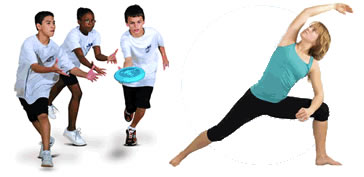
 Physical activity (PA) is really any bodily movement that raises one's heart rate above that at rest. In order for physical activity to be health enhancing, the movements should be moderate enough to make one breathe harder, at least some of the time. Examples include: plan, sports, exercise, as well as lifestyle activities such as walking to a destination, taking the stairs, doing housework and yard work, and performing a variety of jobs that require actively moving.
Physical activity (PA) is really any bodily movement that raises one's heart rate above that at rest. In order for physical activity to be health enhancing, the movements should be moderate enough to make one breathe harder, at least some of the time. Examples include: plan, sports, exercise, as well as lifestyle activities such as walking to a destination, taking the stairs, doing housework and yard work, and performing a variety of jobs that require actively moving.
Physical Activity...
- Promotes health and fitness. Regular physical activity in children and adolescents promotes health and fitness and can lead to a healthy adulthood. Active children tend to become active adults and regular physical activity over months and years can produce long-term health benefits and lengthen a person's life span.
- Build healthy bones and muscles. Compared to those youth who are inactive, physically active youth have stronger muscles and bones. Having strong bones is essential to good posture, strength and balance.
- Reduces the risk of obesity and risk factors for disease. Youth who are regularly active have a better change of a healthy adulthood and avoiding some of the health risks that sedentary children likely face. While many children don't usually develop chronic disease, many of the risk factors for heart disease, high blood pressure and type 2 diabetes can begin to develop early in life. Inactivity can also lead to childhood obesity.
- Reduces the symptoms of anxiety and depression. Regular physical activity appears to reduce symptoms of anxiety and depression in children and adolescents Aerobic activity stimulates various brain chemicals that can produce a sense of well being. Regular physical activity may also improve the quality of sleep.
- Enhances self efficacy, enjoyment and confidence. According to Dr. Albert Bandura, an influential social psychologist, self efficacy is defined as one's confidence in their own ability to develop strategies and complete tasks necessary to be successful in various endeavors (Bandura, 1997). Self efficacy is the belief that one is capable of achieving a goal. youth who regularly participate in physical activity enjoy the confidence that comes with master new experiences, enjoy the support of others such as sports team members or family members cheering them on, and see the success of others which can raise their own belief that they can master comparable activities.
![]()
United States Department of Health and Human Services
Physical Activity Guidelines for Americans - 2018
https://health.gov/sites/default/files/2019-09/Physical_Activity_Guidelines_2nd_edition.pdf
Mayo Clinic
www.mayoclinic.com
Center for Disease Control and Prevention
www.cdc.gov
Bandura, Albert. Self-efficacy: The Exercise of Control. New York: W.H. Freeman, 1997
Bandura, Albert. Social Learning Theory. New York: General Learning Press, 1977














